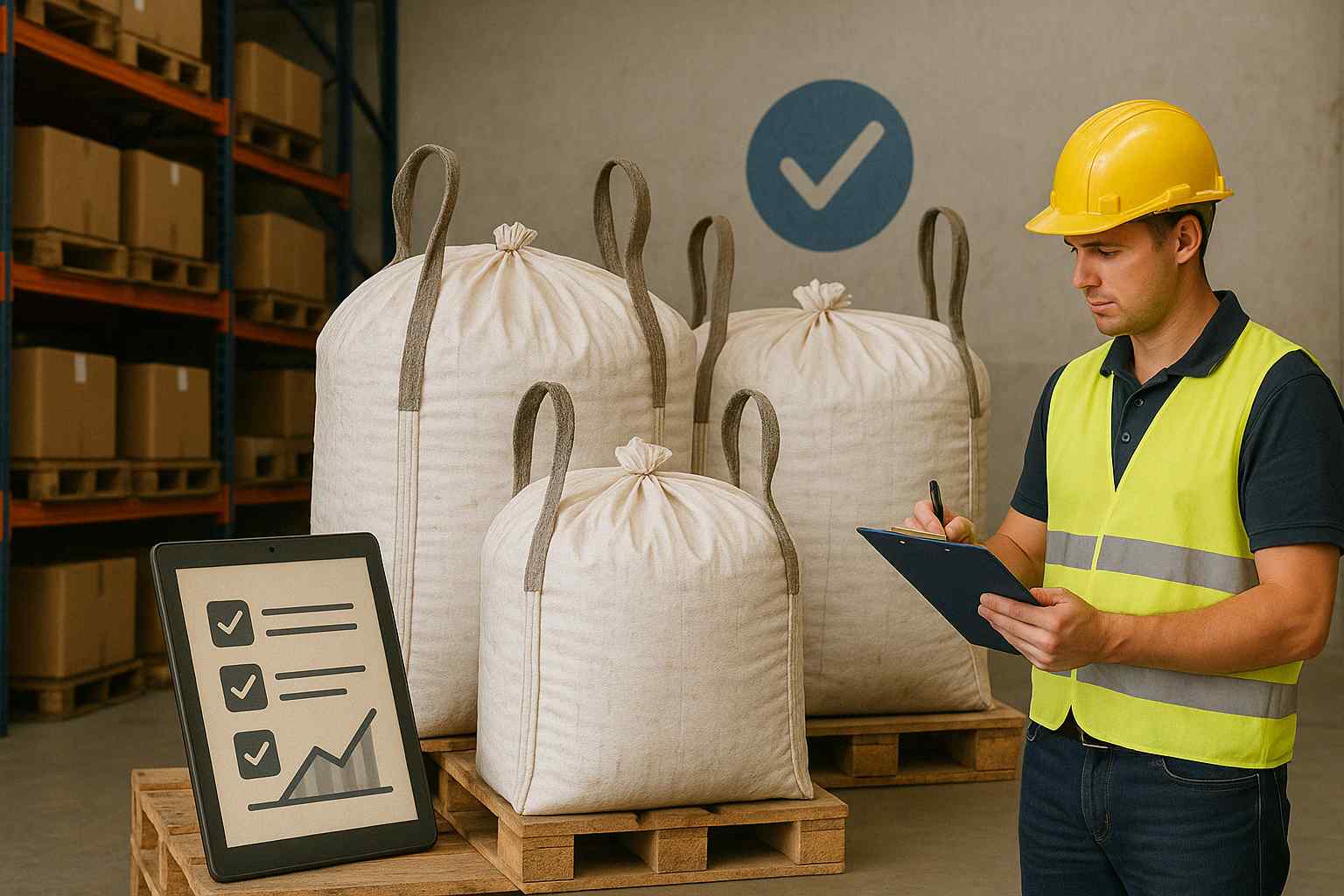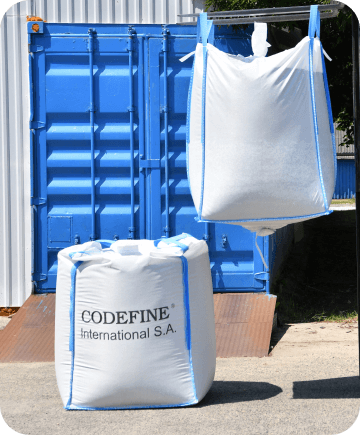Home » Posts Page » Blog » Products and Materials » What Causes FIBC Bag Failures and How to Prevent Them

Today, FIBCs play a crucial role in multiple sectors including agricultural (grain, fertilizers, seeds), chemical manufacturing (powders, granules, compounds), construction (cement, sand, aggregates), food processing (flour, sugar, salt), mining (ores, minerals), pharmaceutical (raw materials), and animal produce (feed, supplements). With such widespread application across critical industries, the integrity of these containers directly impacts operational efficiency, worker safety, and product quality.
Preventing FIBC bag failures isn’t merely about avoiding product loss; it’s about safeguarding personnel, preserving product integrity, meeting regulatory compliance, and maintaining operational continuity. A single bag failure can result in significant financial losses, production delays, and even severe injuries.
Understanding the primary ways FIBCs fail is the first step toward effective prevention. While these industrial workhorses are engineered for durability, they remain susceptible to several distinct failure modes that manifest across different industrial settings.
The most dramatic FIBC failures involve complete structural collapse. These typically occur at critical stress points like lifting loops, seams, and stitching. In high-stress applications such as mining or construction, where bags may contain abrasive materials like crushed stone or cement, the fabric body can experience tears along stress lines. Load distribution problems frequently contribute to these failures, particularly when bags are filled beyond their safe working load (SWL) capacity or lifted unevenly in demanding environments like pharmaceutical or chemical facilities.
Many FIBC failures develop gradually through material degradation. UV exposure weakens polypropylene fibers over time, particularly in agricultural applications where bags may sit outdoors. Chemical reactions between container materials and contents are especially problematic in the chemical industry, where incompatible products can compromise bag integrity. Moisture infiltration leads to fabric weakening and potential mold growth, a critical concern for food and pharmaceutical applications where product purity is paramount.
Operational mistakes represent a significant failure category across all industries. Overfilling beyond rated capacity places excessive stress on seams and lifting points. Improper handling during transport, particularly in fast-paced environments like food processing facilities, can result in punctures or tears. Incorrect discharge techniques that create vacuum or pressure conditions within the bag may cause unexpected failures, while improper forklift operation remains one of the leading causes of bag damage in warehousing operations within mining, agriculture, and construction sectors.
While the symptoms of bag failure are visible, understanding the root causes requires deeper investigation into manufacturing quality, environmental factors, and handling practices that compromise FIBC integrity.
The foundation of bag reliability begins with manufacturing quality. Substandard raw materials, particularly recycled polypropylene with inconsistent tensile strength, significantly increase failure risks. This is especially problematic in regulated industries like pharmaceuticals and food production. Inconsistent stitching techniques at critical seams create weak points that may not be immediately visible but fail under load. Design flaws, including inadequate safety factors for specific applications like chemical handling, can also predispose bags to failure.
Environmental conditions accelerate FIBC degradation across multiple industries. Extended UV radiation exposure breaks down polymer chains, reducing tensile strength by up to 60% within months, a significant concern for agricultural applications where outdoor storage is common. Temperature extremes affect material properties; freezing temperatures increase brittleness, while high temperatures in mining operations or hot climates can soften materials and reduce load capacity.
Even perfectly manufactured bags fail when improperly used. Exceeding safe working load limits, common in construction and mining operations, stresses materials beyond design capacity. Dragging rather than lifting bags creates abrasion points along the bottom surface. Stacking patterns that create uneven pressure distribution lead to deformation and stress concentration. Multiple handling cycles, particularly in the food supply chain, where bags may move through several facilities, can incrementally damage bags through repeated stress. For pharmaceutical and animal feed applications where cleanliness is essential, contamination from handling equipment can compromise both bag integrity and product safety.
The consequences of FIBC failures extend far beyond simple product spillage, potentially affecting worker safety, product integrity, regulatory compliance, and environmental protection.
Personnel safety represents the most critical concern. Catastrophic bag failures during lifting operations can release hundreds or thousands of kilograms of material within seconds, potentially causing crushing injuries or falls, particularly in construction and mining environments. Airborne particulates from spilled materials present respiratory hazards, especially with fine chemicals, pharmaceutical ingredients, or agricultural products like grain dust that can cause occupational asthma.
Selecting appropriate FIBCs for specific applications represents the first defense against failures. Different industries require tailored approaches to bag selection based on material properties, handling requirements, and safety considerations.
Safety factors, the ratio between breaking strength and safe working load, provide critical guidance for selection. Standard FIBCs typically offer 5:1 safety factors, meaning they withstand five times their rated capacity before failure. For hazardous applications in chemical or pharmaceutical industries, higher safety factors (6:1 or greater) provide additional protection. Mining and construction applications involving dynamic loading benefit from reinforced designs with enhanced safety margins. The Safe Working Load (SWL) rating must align with actual operational needs, not just typical load,s but maximum potential weights accounting for material density variations. Agricultural products like grain may seem light but can compress and increase in density, requiring appropriate safety margins.
Material compatibility directly impacts bag longevity. Standard polypropylene suits most applications but breaks down when exposed to UV radiation or certain chemicals. UV-stabilized fabrics extend outdoor lifespan for agricultural and construction applications. Coated fabrics provide moisture barriers for hygroscopic food ingredients like sugar or salt. FDA-compliant materials are essential for direct food contact or pharmaceutical ingredients. Anti-static or conductive fabrics prevent dangerous static discharge when handling flammable materials in chemical processing. Mining applications with abrasive contents benefit from reinforced fabrics with higher denier ratings and specialized coatings.
Even perfectly selected bags require proper handling throughout their lifecycle to prevent failures across all industries.
Proper filling procedures begin with bag stabilization, typically on pallets, ensuring even weight distribution. Center-filling techniques prevent uneven loading stresses common in agricultural and mining applications. Controlled fill rates prevent air entrapment and deformation. During discharge, maintaining bag stability prevents tipping or sudden shifts that create tears. Bottom discharge should proceed at controlled rates, particularly for high-density materials used in construction. Food and pharmaceutical applications require particular attention to equipment cleanliness during loading and discharge to prevent contamination that could compromise product integrity.
Storage conditions significantly impact FIBC longevity. Protect bags from direct sunlight, particularly important for agricultural applications where UV degradation accelerates failure. Maintain climate-controlled environments when possible, especially for food and pharmaceutical materials where temperature fluctuations affect both container and contents. Stack only to recommended heights based on bag type and contents, typically no more than 2-3 bags for heavy construction materials, but potentially higher for lightweight agricultural products. Implement proper warehouse organization with clear segregation to prevent chemical incompatibilities and cross-contamination between product types in multi-use facilities.
Codefine approaches FIBC reliability through comprehensive quality assurance systems specifically designed for diverse industrial applications. Our engineering team incorporates application-specific requirements from agricultural, chemical, construction, food, mining, pharmaceutical, and animal feed sectors into every design, ensuring bags. Contact Codefine’s application specialists today to discuss your specific FIBC requirements and discover how our engineered solutions can eliminate failure risks in your operations. Our team will analyze your specific material handling challenges and recommend tailored solutions that enhance safety, extend service life, and optimize operational efficiency across any industrial application.
